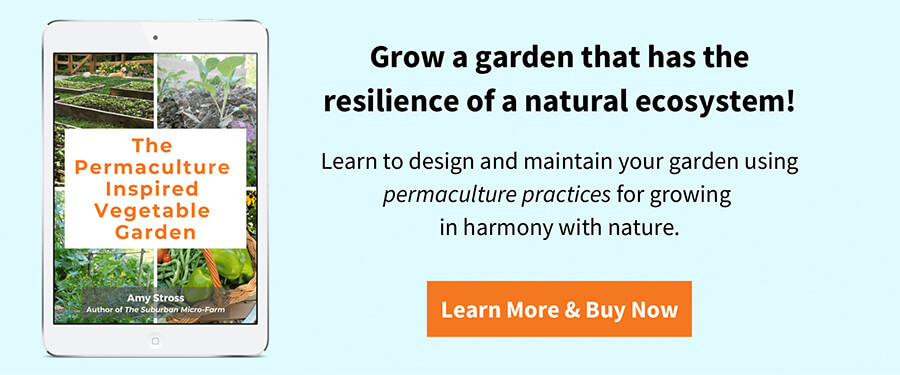12 Steps to Preventing Garden Pests Naturally
Are you frustrated by finding pests in the garden? Don’t waste time and money treating pests. Instead, follow this guide for preventing garden pests from becoming a problem at all.


This page may contain affiliate links. Please read my disclosure for more info.
Pest problems can be disappointing when a hopeful garden season ends abruptly because of a pest infestation. This guide will help you better understand how your garden works so you can grow your best crops. Preventing garden pests is an essential part of your garden maintenance plan.
The Truth About Organic Pesticides
Dealing with pests and disease is a natural part of gardening. Even expert gardeners and farmers experience crop failure from time to time.
PREVENTING garden pests is far easier (and more fun!) than dealing with pest outbreaks AFTER they show up.
You might be surprised to learn that I don’t use pesticide sprays in the garden, even organic or homemade products. That’s because some natural solutions can be as toxic as chemical products to soil life.
Pesticides of any kind (even organic and homemade products) can kill beneficial insects. Killing insects is their purpose, after all! They can alter the pH balance of the soil, leave a toxic residue on the crop, destroy beneficial soil microbes, or a combination of these consequences.
Soap-and-water spray, for example, is commonly used for natural pest control. But it might also kill beneficial soil microbes and change the soil pH, depending on the brand and dilution.
I don’t want to damage my garden ecosystem or poison crops I eat, so I don’t fight pests. If I fail at preventing them, then I learn from them, but I don’t spray.
Naturally Preventing Garden Pests
One of the keys to natural pest management is patience.
For example, the year I replaced the front lawn with an edible landscape, I had quite a few pest problems. I was really disappointed—I had put so much time, money, and effort into creating the garden. I wanted to save it from being devoured by pests!
Instead of making a rash action, however, I waited, and continued to practice all of the following techniques. While I was doing my part, the beneficial soil microbes were getting acquainted with their new environment. These soil organisms duked it out and eventually came into a balance.
I saw progressively more improvement each year as the soil ecosystem matured.
What do soil microbes have to do with pests?
The beneficial soil microbes help feed plants, keeping them healthy and well-protected against pests. If I had sprayed anything, it would have disrupted their establishment period and delayed the balance I desired.
It could have become a never-ending dependence on pesticides. Instead, patience was the answer.
Read more: See How Easily You Can Create an Edible Landscape


our edible front yard
Would you like to yield delicious harvests while partnering with nature? Check out my mini guide, The Permaculture Inspired Vegetable Garden.
12 Steps to Preventing Garden Pests
The following are some ways for preventing pests from taking over your garden without the use of chemicals.
For an example of how this can play out for a specific crop, see: Grow the Best Cucumbers with These 12 Steps
#1: Encourage healthy soil.
Healthy soil makes healthy plants with strong immune systems, which are better able to fight off diseases and pests. Healthy soils feed and shelter beneficial soil life.
Natural fertilizers help build healthy soil. Fish and seaweed fertilizer, used once a month, can activate soil microbes.
See: 7 Ways to Improve Soil Quality
#2: Choose resistant varieties.
This is an easy tip for preventing garden pests: Choose plant varieties that are naturally resistant to pests. Seed catalogs list varieties that are known for resistance.
For example, tromboncino squash appears to be more resistant to pests than other summer squash varieties.
Check out this article for more interesting notes on choosing resistant varieties.
#3: Plant in the right place.
Reserve plants that need full sun for full sun areas. Likewise, plant crops according to water needs. If a crop requires more water to stay healthy, grow it in an area that stays moist longer.
Crops may tolerate less than ideal conditions for a time, but eventually the stress will weaken them and they can succumb to pests. Planting in the right place is an easy step toward preventing garden pests.
#4: Attract beneficial insects.
Beneficial insects prey on pests, and they will naturally come to your garden in search of nectar, pollen, and shelter. Encourage them to stick around by growing flowers that meet these needs.
For example, some of my favorite annuals are: calendula, coriander, and sweet alyssum.
See:
Plant tall flowers and perennials at the garden edge, such as: comfrey, sunflowers, and yarrow.
See: Growing Comfrey in the Permaculture Garden
Provide beneficial insects with habitat and they will lay their eggs nearby to grow an army. Beneficial insect patrols are key in preventing garden pests.


Swiss chard & sweet alyssum border
Would you like to learn more about improving the biodiversity of your garden to reduce maintenance and increase yield?
You’ll find loads of information just like this in my award-winning book, The Suburban Micro-Farm.
#5: Repel pests.
Strong-scented herbs can deter pests when planted among or near the vegetables. This is a super-easy way to support your efforts in preventing garden pests.
Some of my favorite strong-scented annuals include calendula, coriander, and garlic.
Plant strong-scented, perennial herbs at the edge. Anise hyssop, chives, and thyme are some of my favorites.
See:
#6: Rotate crops.
Crop rotation confuses pests, reduces their concentration in specific areas, and helps you manage soil fertility.
Leave two to three years between planting members of the same crop family in a particular area.
Of course, this can be challenging in a small or shady garden. However, if a crop is overcome by a pest, don’t plant it in that spot for at least two years. Or plant a cover crop to allow that area to rest for a season.
This is a difficult step to take in preventing garden pests, but your patience will pay off.
#7: Practice interplanting.
Interplanting means alternating specific crops, herbs, and flowers to confuse pests. Pests enjoy monocrops, which is why industrial farms are often heavily sprayed with pesticides. Instead of monocrops, alternate rows of vegetables with rows of beneficial insect-attracting and pest-repelling herbs and flowers.
Confusing pests is a sneaky trick for preventing garden pests from finding your crops. For example, I interplant my cabbage family crops with cilantro, calendula, and onions.
See: 7 Reasons to Grow Calendula.


aphids on calendula stalks (ladybug buffet!)
#8: Use floating row covers.
Summer-weight row cover allows water and light to penetrate while keeping pests out. You may only need to use floating row cover over young plants until they’re established. Weigh down the sides with heavy objects like bricks or rocks.
If a particular pest on a particular crop seems to be a recurring problem for you—and you’ve followed the other tips in this article to the letter—you might consider using permanent low tunnel hoops for the problem crop.
Be sure to lift the cover for a few hours each morning to let pollinators in.
#9: Create permanent walkways.
Permanent pathways encourage beneficial insects while temporary pathways that are tilled each year destroy them and their habitat.
The type of pathway material you use will depend on your specific situation. White clover, wood chips, or gravel are a few of my favorites.
Having permanent pathways allows you to have permanent beds where you can continue to build fertility over time. Better fertility can, of course, support your garden’s resistance to ‘catching a bug’.
#10: Found a few pests? Leave them be.
Having a few pests is actually a good thing. Seems counterproductive, but without a few pest “baits”, the beneficial insects that dine on them wouldn’t stick around! Beneficial insects are attracted to gardens that have their favorite foods.
In other words, the occasional pest “bait” is okay.
#11: Handle an outbreak.
When a few pests turn into an outbreak, remove infested plants to keep the damage from spreading.
It bears repeating that I don’t promote treating pests with pesticides—organic or not. Rather, start back at #1 above and work through the prevention tactics in this guide.
However, if you’re going to treat an outbreak, identify pests, beneficial insects, AND the larval stages of each. Take a look at the photo below: Did you know that these critters are ladybug larvae, a precious beneficial insect?
Destroying beneficial insects reduces the ability of your garden ecosystem to self-regulate.
TIP: Click here for a database of photos for beneficial insects and pests throughout their life cycles.


ladybug larvae on kale (beneficial predators!)
#12: Be proactive rather than reactive.
A pest outbreak is an opportunity to learn how to strengthen your garden ecosystem.
Example: Is your soil lacking a mineral that is making your plants sick enough to catch a “bug”? If so, what organic material might supply it?
Having a few pests is a natural part of gardening. It reminds me that I want to work with nature rather than against it. I choose NOT to wage war on nature, even when it means a lesson in patience.
Tracking Pests
Keep notes of the pests you encounter, when they showed up, what treatments you try, and the outcome of those actions. When we become detectives, we can determine where to focus our attention in our journey to preventing garden pests.
With the purchase of my book The Suburban Micro-Farm you’ll get a variety of free bonus materials—including my monthly checklists with room for taking important notes like these!
Summary
Preventing garden pests naturally will strengthen your garden’s immune system so it doesn’t ‘catch a bug’.
Have you been successful in preventing garden garden pests? What practices have helped you create a healthy garden?
READ NEXT:
>>> Get my free 19-page Guide to Organic Soil Amendments for more ideas:









